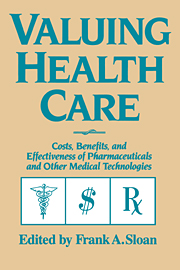 Valuing Health Care
Valuing Health Care Published online by Cambridge University Press: 07 December 2009
Ideals and realities in cost measurement
Medical treatment involving pharmaceuticals usually requires a substantial number and variety of additional medical resources. During a patient's hospital stay, for example, personnel, including nurses, technicians, therapists, and orderlies, will allocate some of their time to caring for and attending to the patient's many needs. In addition to these labor inputs, the attending physician may order the use of expensive equipment for diagnosis and treatment. Other medical supplies must be obtained and administered. Pharmaceutical treatment in other settings involves a similarly wide anay of medical resources. The other principal resource used in the medical process is the time of the patient and his or her family.
When resources are used to provide medical care for one patient, they are unavailable for other patients and other societal uses. Thus, one cannot judge the merits of a medical intervention without understanding what one is giving up to provide that intervention. What providers and society give up to provide treatment for an individual is called the cost of the treatment.
This chapter presents a series of conceptual guidelines to help the researcher measure the costs of medical treatment. The fundamental economic concept of opportunity cost is introduced first. This concept is essential to understanding the importance of perspective, which is discussed in the next section. These points are then used to show how the analyst can determine which costs should be included in the analysis.
To save this book to your Kindle, first ensure [email protected] is added to your Approved Personal Document E-mail List under your Personal Document Settings on the Manage Your Content and Devices page of your Amazon account. Then enter the ‘name’ part of your Kindle email address below. Find out more about saving to your Kindle.
Note you can select to save to either the @free.kindle.com or @kindle.com variations. ‘@free.kindle.com’ emails are free but can only be saved to your device when it is connected to wi-fi. ‘@kindle.com’ emails can be delivered even when you are not connected to wi-fi, but note that service fees apply.
Find out more about the Kindle Personal Document Service.
To save content items to your account, please confirm that you agree to abide by our usage policies. If this is the first time you use this feature, you will be asked to authorise Cambridge Core to connect with your account. Find out more about saving content to Dropbox.
To save content items to your account, please confirm that you agree to abide by our usage policies. If this is the first time you use this feature, you will be asked to authorise Cambridge Core to connect with your account. Find out more about saving content to Google Drive.